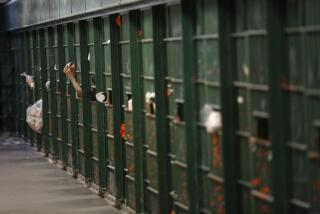Reality TV: Prison shows break new ground with female inmates
Watch a few episodes of your typical prison documentary series — MSNBC’s “Lockup,” say — and there are certain things you’re almost guaranteed to see: shanks handcrafted from common jailhouse items. Inmates hurling feces at ticked-off guards. Facial tattoos.
What you’re not likely to see are inmates talking about their feelings or working on their problems through anger management. Most of all, you’re not going to see a lot of women. Until now.
Female inmates are infiltrating the prison show genre, and with them has come a marked emphasis on rehabilitation and transformation. There are drug rehab programs on “Cell Block 6: Female Lock Up” and parenting classes on “Babies Behind Bars,” both of which recently aired on TLC. The premiere episode of A&E’s documentary series “Beyond Scared Straight,” which was filmed inside Valley State Prison for Women in Chowchilla, Calif., and lured 3.7 million viewers, featured one-on-one sessions between lifers and at-risk teens.
And on “Breaking Down the Bars,” which recently concluded its first season on Oprah’s OWN, producers brought their own clinical psychologist to Indiana’s Rockville Correctional Facility to supplement the prison’s existing staff.
The counseling on “Breaking Down the Bars” ranges from practical anger-management tips — when someone irks you, advises the show’s Stephanie Covington, take some cool-down time to write it all down, then stick the notes in a little box — to an intensive six-month drug rehab program. Without that rehabilitative component, says Lisa Erspamer, the network’s chief creative officer, OWN would have passed on the series.
“If it was just a look inside prison life, that wouldn’t have been as compelling to us,” Erspamer says. “The redemption and second-chance aspects of the show felt like the right fit for our audience.”
Fit and good intentions aside, the focus on prisoner rehab also makes for riveting TV. Without the counseling sessions, viewers might not have learned why Lisa shot her husband several times in the shower or why Michelle was caught with 58 grams of crack cocaine stuffed between her breasts.
“Most of our other prison shows just kind of dealt with these stories on a surface level,” says “Breaking” producer Rasha Drachkovitch, who has spent much of the last decade working on “Lockup,” which first aired on MSNBC in 2000. “But here we could actually drill deeper and even change lives, which is exciting.”
The spiritual sire of the current prison TV genre is “Scared Straight,” the groundbreaking Oscar-winning 1978 documentary produced by Arnold Shapiro. While scouting locations for the follow-up, “Beyond Scared Straight,” Shapiro visited men’s and women’s facilities in California, Maryland and South Carolina. The scariest of the bunch, male or female? The women’s prison in Chowchilla.
“Beyond” takes a look inside seven prisons, five male lockups and two female ones. The Chowchilla episode — with its mix of hard luck stories and its scenes of unabashed terrorizing of high school-age girls — became A&E’s highest-rated premiere for an original series.
The inmates are just as terrifying as in the original “Scared Straight,” the at-risk teen girls just as scared. But where once there were just inmates screaming at the kids, now there are counseling sessions afterward. The juxtaposition is eerie, as hardened lifers go from driving kids to tears to pleading with them to listen to their moms.
“You can be a very dangerous, destructive criminal in the outside world, but that doesn’t mean that you don’t have a place in your heart where you really want to help kids avoid your mistakes,” Shapiro says. “It doesn’t mean that they’ve necessarily changed. But so many of these women have children or nieces and nephews, so they try to use their experiences in a positive way for the benefit of the girls.”
Intentionally or not, these shows often seem to send mixed messages about the value of these programs, highlighting their effectiveness even as they call into question why many of these women — many serving stiff sentences for nonviolent crimes — are in prison in the first place. One inmate on “Breaking” is serving a four-year sentence for trying to rob a hotel clerk armed only with her boyfriend’s pellet gun (the attempt, caught on surveillance video, is as half-hearted as it is inept); another got 15 years for selling her methadone.
“Many of these programs are almost like mini-human rights films,” says Laurie Ouellette, co-author of “Better Living Through Reality TV: Television and Post-Welfare Citizenship.” “But you have to read against the packaging to see that. I don’t think that that’s the way they’re necessarily promoted or conceived.”
One of the most intriguing characters in “Breaking Down the Bars” is a young mother named Tiffany who, when the series begins, is due to be released in three months but seems to be doing everything in her power to sabotage her homecoming. She fights with her prison mates and gets sent to a segregation unit three days before her scheduled release date after a tussle with the guards.
Her behavior is as frustrating as it is inexplicable, and on a lot of prison shows the story might have ended there. But through the prodding of counselors and case workers, Tiffany’s past is slowly revealed: Her father was murdered by her mother when she was 4. Sexually abused by her brother at 11. Gang raped at 17. “Dr. Covington was able to unlock some things that they had never talked about before,” says Drachkovitch.
There’s an ever-replenishing supply of stories like Tiffany’s to fuel any number of prison shows, and both Shapiro and Drachkovitch have ideas for second seasons should their series get renewed. Drachkovitch is looking at prisons in Alaska and Hawaii; Shapiro hopes for more episodes in Chowchilla.
“You see them hit rock bottom,” Drachkovitch says when asked about the appeal of such shows. “There’s mail call, and everybody gets a letter, but their mother doesn’t write them. You get the inmate who calls home for support, and the mother won’t accept the collect call. And then you see a woman get her GED. You see the highs and lows.”
More to Read
The biggest entertainment stories
Get our big stories about Hollywood, film, television, music, arts, culture and more right in your inbox as soon as they publish.
You may occasionally receive promotional content from the Los Angeles Times.










